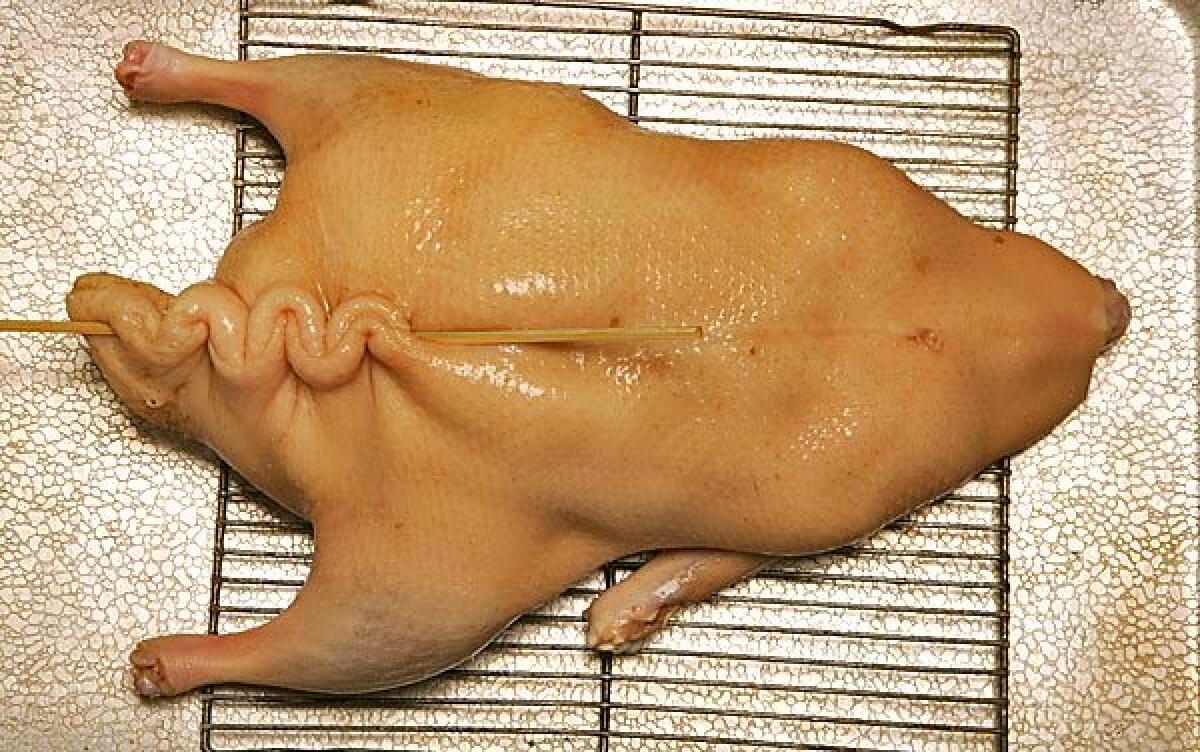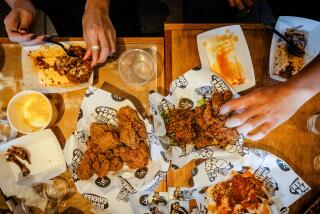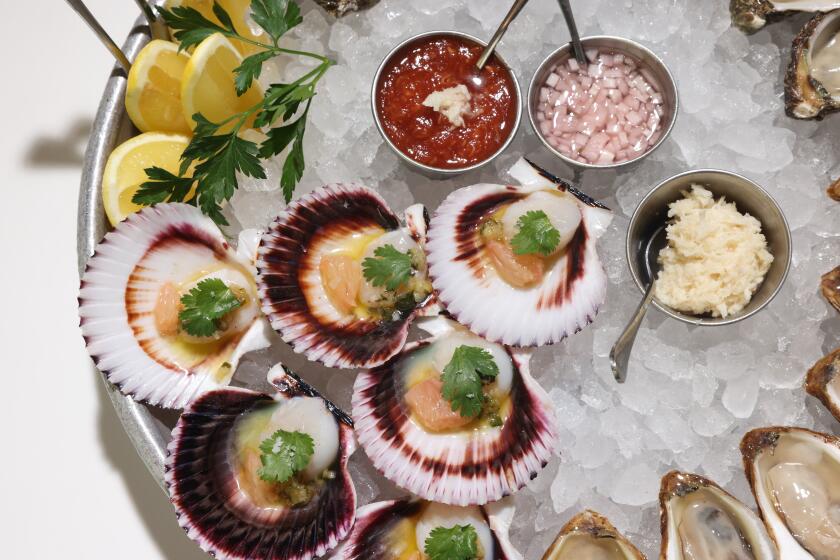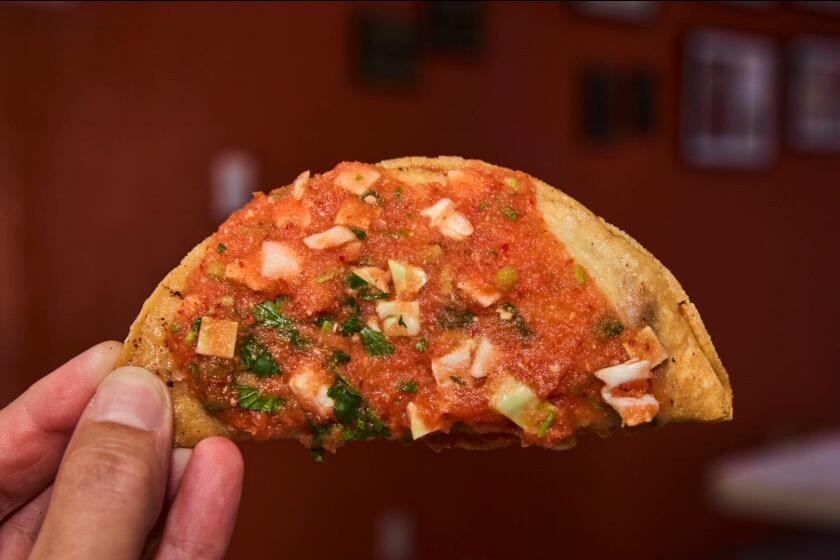Recipe: Peking duck

Peking duck
Total time: 1 hour, 40 minutes, plus 1 1/2 days chilling time
Servings: 4 to 6
Note: This recipe requires the use of a small pump (such as a bicycle pump); the duck can be inflated by hand using a bamboo straw or turkey baster, though this requires a bit of effort. This recipe also requires the use of a vertical roaster. Look for ducks with their heads and feet attached at 99 Ranch markets and specialty shops such as Shang Lee Fresh Poultry (711 N. Spring St.) and Superior Poultry (750 N. Broadway) in Chinatown. Also check with farmers market vendors such as Healthy Family Farms.
Earthy and vaguely chocolaty sweet bean sauce is the traditional condiment enjoyed with Peking duck; hoisin sauce is more widely available but much sweeter. At Chinese markets, look for the sweet bean sauce (a.k.a. sweetened bean paste) in the condiment aisle and select the canned Szechuan brand or the jarred Ming Teh brand. The former is a tad smoky and the latter is winey.
1 (4- to 5-pound) duck, with head and feet intact
2 tablespoons salt
3 cups plus 1 tablespoon water, divided
2/3 cup plus 2 teaspoons Shaoxing rice wine or dry sherry, divided
3 tablespoons honey
1 tablespoon light (regular) soy sauce
11/2 teaspoons plus 1 tablespoon dark (thick) soy sauce, divided
1/4 cup sweet bean sauce or hoisin sauce
1 teaspoon sugar, optional
1 teaspoon sesame oil, optional
4 or 5 slender green onions, cut crosswise into 3-inch lengths and lengthwise into thin strips
1 small English, or 2 Armenian cucumbers, quartered lengthwise, seeded and sliced into thin strips
12 to 14 prepared mandarin pancakes
1. Prepare the duck: Remove any excess fat in the body cavity near the rear opening. To refresh the duck, vigorously rub the salt into its cavity and on its skin. Rinse, drain and pat dry with paper towel.
2. Put the duck, breast side up, on a baking sheet. Sew up the duck’s abdominal cavity with a bamboo skewer; break off the protruding excess skewer, if you like.
3. To inflate the duck, use the tip of a paring knife to pierce a hole at the bottom of the duck’s neck. Aim for the firm center just above the wishbone.
4. Inflate the duck, directing air to one side, then the other. The duck should puff up to reveal a six-pack abs-like structure. If the duck just puffs a little, then you may be pumping air into the cavity and not under the skin. Reposition the nozzle higher. If there is an air leak in the skin, make a new hole below the original one and retry. Flip the duck over and inflate its backside, making a hole at the top of the spine. Expect the duck to lose some air once you remove the pump nozzle.
5. Put the duck on a cutting board and use a heavy cleaver or knife to cut off its legs, right below the knee joint. Then cut off the first two joints of its wings. Finally cut off its neck, leaving about 2 inches attached to the body. Cut the head from the neck and discard. Refrigerate the remaining spare parts (neck bone, wing tips, feet) for the broth. Put the duck, breast side up, on a vertical roasting rack placed on a baking sheet and set near the stove.
6. In a saucepan, combine 3 cups water, two-thirds cup rice wine, honey, light soy sauce and 1 1/2 teaspoons of the dark soy sauce. Bring to a boil, then reduce the heat to maintain a good simmer.
7. Slowly ladle two-thirds of the mixture on the duck, bathing it from the top of its thighs to the top of its neck. Partway through, flip the duck over and repeat on its backside.
8. Now add the remaining 1 tablespoon of dark soy sauce to the leftover mixture, stir and ladle the liquid over the lower portion of the duck. It’s OK if some of this darker liquid runs to the upper part.
9. Lift the duck off the rack and set aside briefly. Discard the pooled liquid and wash the rack and baking sheet. Replace the rack in the baking sheet, then put the duck on top, breast side up. Slide the duck into the refrigerator and let it air chill, uncovered, for 1 1/2 days, roughly 36 hours. Expect the skin to darken as it dries and to feel somewhat like parchment paper. (The mandarin pancakes can be made ahead of time while the duck dries.)
10. Return the dried duck to room temperature before roasting. Position a rack in the lower third or bottom of the oven to allow the duck to roast upright in the middle of the oven; the top of its neck should be about 3 inches from the broiler element. While the duck is warming, heat the oven to 450 degrees.
11. If needed, lightly spray or oil the vertical roaster. Turn and pull out the bamboo skewer to open the duck’s body cavity by about 3 inches. Insert the vertical roaster. It’s OK if the duck leans forward or slouches a bit. Place the duck in a roasting pan, add a good quarter inch of water, then slide the pan into the oven.
12. Roast for 15 minutes, then lower the temperature to 350 degrees and continue roasting until the skin is crisp, richly browned and shiny, about 1 to 1 1/4 hours. Rotate the pan as needed so the skin browns evenly. When it is ready, the skin should sound hollow when gently tapped.
13. While the duck roasts, ready the accompaniments. To make the sauce, whisk together the bean sauce, remaining 2 teaspoons rice wine and remaining tablespoon water in a small bowl. Taste and add sugar, sesame oil or both as desired. The sauce is ready to use.
14. Put the green onions and cucumber on one or two plates. Place the sauce and vegetable garnishes on the table, and ready the steamer and mandarin pancakes for reheating.
15. When the duck is done, remove from the oven and set aside to rest for 10 to 15 minutes.
16. Twist and completely pull out the skewer . To remove the skin without it getting soggy, keep the duck on the roaster. Visualize the duck skin as four long quadrants. Now use a knife to cut downward through the skin, first to split the breast, then down the two sides and the back. Pry and peel away the large pieces of skin. You will have to make some additional horizontal cuts to remove the skin. Set the skin aside on a plate as you work.
17. Remove the vertical roaster from the skinless duck, and disassemble the carcass, cutting or pulling the flesh off the bones. Prepare to present the meat alongside the skin, setting aside 1 1/2 cups if desired to make the stir-fry recipe. (As the duck is broken down, save the carcass to add to the duck broth recipe if desired.) Reserve the 1 1/2 cups (one-half pound) of meat for the stir-fry and save the remainder to present alongside the skin.
19. Break up the carcass and add it to the soup, along with any leftover bits. Simmer the soup as directed.
18. To serve, cut the skin into pieces about 1 by 2 inches, and arrange on a platter. Include the duck meat. At the table, invite guests to take a pancake, smear on some sauce and top with a piece of skin, a piece of meat and a few green onion and cucumber strips. Fold or roll up the pancake and eat.
Each of 6 servings: 724 calories; 33 grams protein; 36 grams carbohydrates; 2 grams fiber; 47 grams fat; 15 grams saturated fat; 128 mg. cholesterol; 6 grams sugar; 1,526 mg. sodium.
More to Read
Eat your way across L.A.
Get our weekly Tasting Notes newsletter for reviews, news and more.
You may occasionally receive promotional content from the Los Angeles Times.










